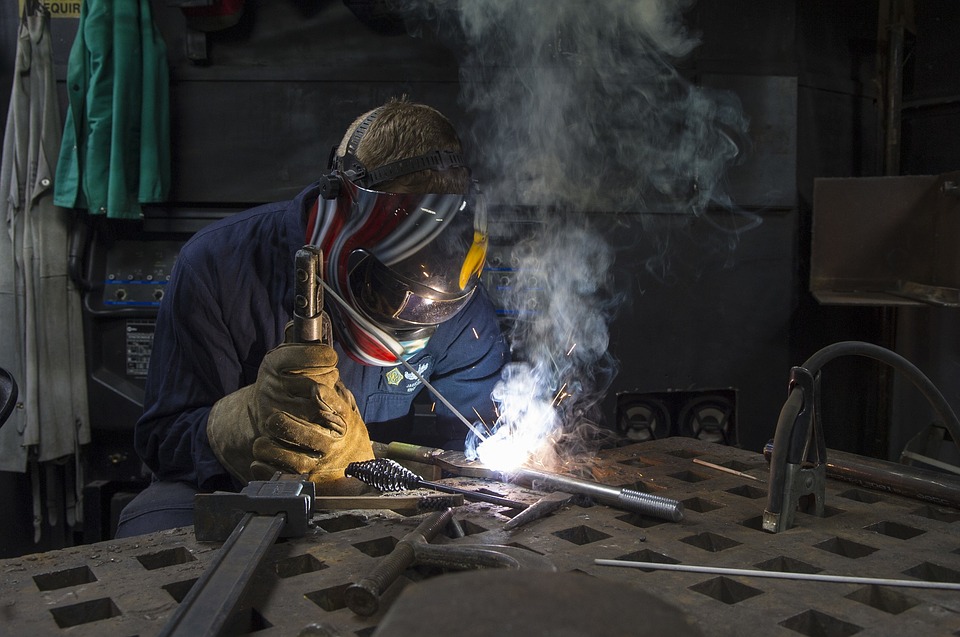Welding
Welding is the creation or sculpting procedure that connects material, generally metal or thermodynamic plastics, by utilizing high temperatures to dissolve the pieces into each other and enabling them to chill, which causes unification. Welding is different from cooler temp material-uniting methods like soldering or even brazing, which do not dissolve the initial material.

Additionally, when dissolving the initial materials, another substance is generally brought in to the point of contact to create a mixture of dissolving substances (the weld solution) that lowers in temperature to create a point of contact that, dependent on weld settings, may be more resistant than the initial substance (founding material). Force per unit area can also be utilized in concoction with high temperatures, or be it alone, to create a fusion. Welding also requisites a type of protection to defend the other substances or dissolved materials from being infected or oxygenated. More information on welding, specifically friction stir welding, can be found at MegaStir.
A lot of varying electronic-stimulating originations may be utilized in welding, inclusive of a gaseous fire (molecular structure), an electronic arc (electron-based), a pinpoint beam of light, a beam of electrons, physical contact stimulation, and also ultrasound-based technologies. Though usually a commercial procedure, welding may be executed in an array of differing surroundings, inclusive of wide-open space, submerged in aqua, and also in the outside regions of our atmosphere. Welding is a potentially dangerous activity and precautious nature is necessary to remain free of heat injuries, electrical exposure, sight injuries, the intake of toxic gaseous chemicals and fumigation, and also vulnerabilities to high-density UV radiating energies.
Up to the ending of the nineteenth century, the single-known welding procedure was forge welding. Blacksmiths had used this procedure for quite a long time to combine iron and steel by increasing their temperatures and then hitting with a hammer repeatedly. Arc welding and oxygen-based fueling welding were some of the beginning methods to be engineered later in the time frame, and electrical strength welding came soon after. Welding advances came about very rapidly during the beginning portions of the 20th century as the population and wars created a high need for dependable and cheap combining procedures. After the wars, there were quite a few up-to-date welding methods created, inclusive of laborious hand techniques, like protected metal arc welding, which is nowadays one of the most commonly used welding procedures, as well as somewhat auto and fully automatic procedures like gas metal arc welding, aqua arc welding, flux-driven arc welding and also electronic sag welding. Advances persisted with the creation of laser beam-based welding, electron beam-based welding, magnetic pulse-based welding, and friction stirring welding in the later part of the 19th century.
Nowadays, the study persists to develop. Robotic welding is common in commercial environments, and research persists to advance newer welding techniques and gather more comprehension of weld effectiveness. Steel is a commonly used metal in welding.
The past of combining materials dates back a few millennia. The first known instances of this come from the Iron and Bronze times in Europe and also in the Middle East. The past Greek-based history professional Herodotus says in The Histories of the 5th century BC that Glaucus of Chios “was the person who singly by himself created iron welding.” Welding was utilized in the building of the iron pillar of Delhi, put up in Delhi, India, around 310 AD and weighed about 5.4 metric tons.
During the Middle Ages came technologies in force welding, in that blacksmiths hammered metal with a super-fast electron composition over and over again till joining happened. In 1540, Vannoccio Biringuccio publicized De la pirotechnia, in that included statements of the procedure of forging. Handymen of the Renaissance were well-to-do with the procedures and the associated work persisted to develop in the centuries to come.
Around 1800, Sir Humphry Davy had found the small-beat electronic arc and represented his discoveries in 1801. Russian-based science man, Vasily Petrov, developed the persistent electric arc, and then after publicized “News of Galvanic-Voltaic Experiments” in 1803. In that, he exampled works that were undertaken in 1802. Of major recognition in this finding was the example of a continuous arc depletion and the pointing out of its potential utilizations for a wide variety of different uses, one being dissolving metals.
